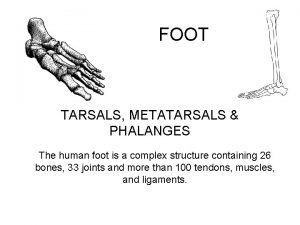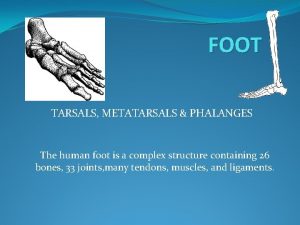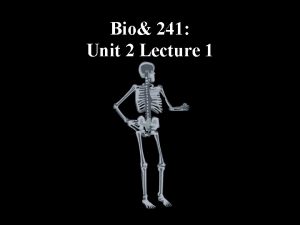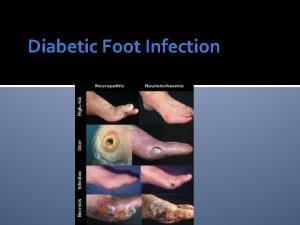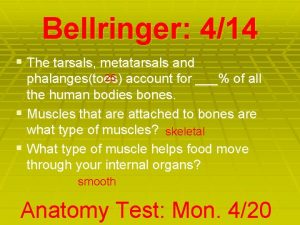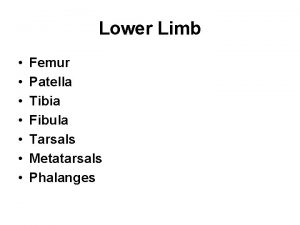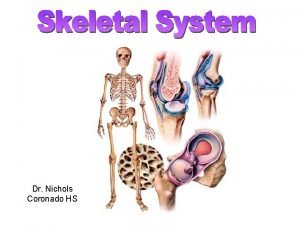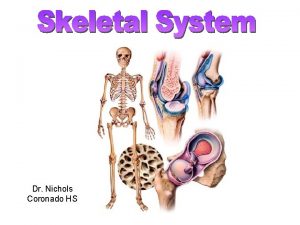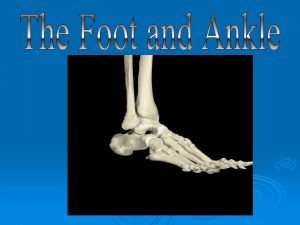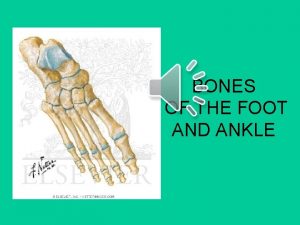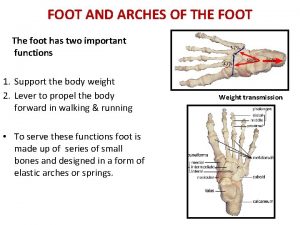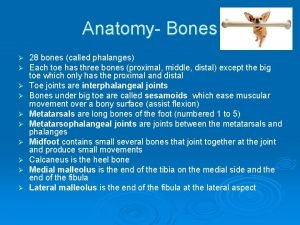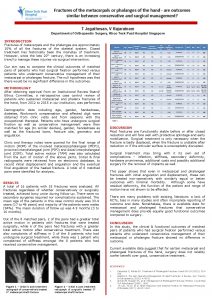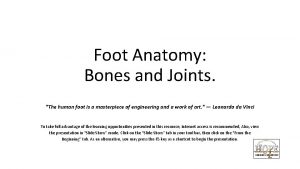FOOT TARSALS METATARSALS PHALANGES The human foot is




![Metatarsus � 5 metatarsal bones: numbered I – V [ 1 – 5] medial Metatarsus � 5 metatarsal bones: numbered I – V [ 1 – 5] medial](https://slidetodoc.com/presentation_image_h/95249591d97bac6ad12d03e9b9641709/image-5.jpg)

![Phalanges [digits] �Numbered I – V medial to lateral �Each phalanx : proximal base, Phalanges [digits] �Numbered I – V medial to lateral �Each phalanx : proximal base,](https://slidetodoc.com/presentation_image_h/95249591d97bac6ad12d03e9b9641709/image-7.jpg)
![Phalanges [digits] �Numbered I – V medial to lateral �Each phalanx : proximal base, Phalanges [digits] �Numbered I – V medial to lateral �Each phalanx : proximal base,](https://slidetodoc.com/presentation_image_h/95249591d97bac6ad12d03e9b9641709/image-8.jpg)








- Slides: 16

FOOT TARSALS, METATARSALS & PHALANGES The human foot is a complex structure containing 26 bones, 33 joints, many tendons, muscles, and ligaments.

Tarsus = ankle �Proximal region of the foot � 7 tarsal bones �Talus: ankle bone �Calcaneus: heel bone �Navicular: ‘like a little boat’ � 3 Cuniform bones: wedge shaped - lateral, intermediate, medial �Cuboid: cube shaped


![Metatarsus 5 metatarsal bones numbered I V 1 5 medial Metatarsus � 5 metatarsal bones: numbered I – V [ 1 – 5] medial](https://slidetodoc.com/presentation_image_h/95249591d97bac6ad12d03e9b9641709/image-5.jpg)
Metatarsus � 5 metatarsal bones: numbered I – V [ 1 – 5] medial to lateral �Each has a proximal base, an intermediate shaft and a distal head �articulate proximally with the first second and third cuneiform bones and the cuboid to form the tarsometatarsal joints �Articulate distally with the phalanges to form the metatarsophalangeal joint

![Phalanges digits Numbered I V medial to lateral Each phalanx proximal base Phalanges [digits] �Numbered I – V medial to lateral �Each phalanx : proximal base,](https://slidetodoc.com/presentation_image_h/95249591d97bac6ad12d03e9b9641709/image-7.jpg)
Phalanges [digits] �Numbered I – V medial to lateral �Each phalanx : proximal base, intermediate shaft and distal head. �Hallux: has two phalanges [proximal & distal] �Other toes have three phalanges: proximal, middle and distal �Interphalangeal joints [between phalanges]
![Phalanges digits Numbered I V medial to lateral Each phalanx proximal base Phalanges [digits] �Numbered I – V medial to lateral �Each phalanx : proximal base,](https://slidetodoc.com/presentation_image_h/95249591d97bac6ad12d03e9b9641709/image-8.jpg)
Phalanges [digits] �Numbered I – V medial to lateral �Each phalanx : proximal base, intermediate shaft and distal head. �Hallux: has two phalanges [proximal & distal] �Other toes have three phalanges: proximal, middle and distal �Interphalangeal joints [between phalanges]

SOLE �SKIN �SUPERFICIAL FASCIA �DEEP FASCIA(plantar aponeurosis) �MUSCLES �NERVES �VESSELS



SOLE FIRST LAYER �ABDUCTOR HALLUCIS �FLEXOR DIGITORUM BREVIS �ABDUCTOR DIGITI MINIMI

SOLE 2 ND LAYER � TENDON OF FLEXOR HALLUCIS LONGUS � TENDON OF FLEXOR DIGITORUM LONGUS � FLEXOR DIGITORUM ACCESSORIUS � LUMBRICALS

SOLE THIRD LAYER � FLEXOR HALLUCIS BREVIS � ADDUCTOR HALLUCIS � FLEXOR DIGITI MINIMI BREVIS

SOLE 4 TH LAYER � 4 DORSAL INTEROSSEI � 3 PALMAR INTEROSSEI � TENDON OF TIBIALIS POSTERIOR � TENDON OF PERONEUS LONGUS

Applied anatomy � Plantar Fasciitis: "heel spurs“: an overuse injury affecting the sole or flexor surface (plantar) of the foot. A diagnosis of plantar fasciitis means you have inflamed the tough, fibrous band of tissue (fascia) connecting your heel bone to the base of your toes. � Higher risk: female, overweight, a job that requires a lot of walking or standing on hard surfaces; walk or run for exercise, especially if you have tight calf muscles that limit how far you can flex your ankles. People with very flat feet or very high arches are also more prone to plantar fasciitis. • starts gradually with mild pain at the heel bone often referred to as a stone bruise. • more likely to feel it after (not during) exercise. • The pain classically occurs again after arising from a midday lunch break. � If you don't treat plantar fasciitis, it may become a chronic condition. You may not be able to keep up your level of activity and you may also develop symptoms of foot, knee, hip and back problems because of the way plantar fasciitis changes the way you walk.
 Tarsals metatarsals phalanges
Tarsals metatarsals phalanges Tarsals metatarsals and phalanges
Tarsals metatarsals and phalanges Tarsals lecture
Tarsals lecture Tarsals lecture
Tarsals lecture Guttering between metatarsals
Guttering between metatarsals 5 function of skeletal system
5 function of skeletal system Put your right foot in
Put your right foot in Find m∠g, rounded to the nearest degree.
Find m∠g, rounded to the nearest degree. Tư thế ngồi viết
Tư thế ngồi viết Thẻ vin
Thẻ vin Gấu đi như thế nào
Gấu đi như thế nào Thể thơ truyền thống
Thể thơ truyền thống Các châu lục và đại dương trên thế giới
Các châu lục và đại dương trên thế giới Từ ngữ thể hiện lòng nhân hậu
Từ ngữ thể hiện lòng nhân hậu Diễn thế sinh thái là
Diễn thế sinh thái là Vẽ hình chiếu vuông góc của vật thể sau
Vẽ hình chiếu vuông góc của vật thể sau Lp html
Lp html
